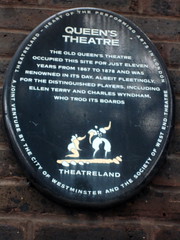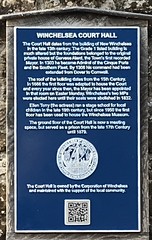Dame Ellen Terry DBE


Dame Ellen Terry DBE
(1847-1928)
woman, actor, and Dame Commander of the Most Excellent Order of the British Empire (from 1925)
Family tree
mistress of Edward William Godwin 1868-74
Commemorated on 8 plaques
Ellen Terry 1847-1928 actress lived here
22 Barkston Gardens, Kensington and Chelsea, SW5, London, United Kingdom where they lived
Ellen Terry The great actress lived here from 1904 to 1920
211 Kings Road, Chelsea, London, United Kingdom where they lived
Queen's Theatre The old Queen's Theatre occupied this site for just eleven years from 1867 to 1878 and was renowned in its day, albeit fleetingly, for the distinguished players, including Ellen Terry and Charles Wyndham, who trod its boards
Long Acre, Covent Garden, London, United Kingdom where they trod the boards
Harrogate Theatre. Opened on 13 January 1900 as the Grand Opera House, designed by F.A. Tugwell, with a fine foyer frieze by Frances Darlington added later, the building was refurbished in the mid 1970s and 2007-9 and is home to theatrical activities that have flourished in Harrogate since the 1760s. Performers who have appeared here include Sarah Bernhardt, Mrs Patrick Campbell, Charlie Chaplin, Sonia Dresdel, Trevor Howard, George Robey, Ellen Terry, Arnold Ridley, Fats Waller, Ken Dodd, Martin Shaw, Ben Kingsley and Eddie Izzard. Home of the White Rose Players 1933-1955.
Oxford Street, Harrogate, United Kingdom where they performed
In loving memory of Ellen Terry, actress. Born Coventry, 1847. Died Smallhythe 1928.
smallhythe road, Smallhythe, United Kingdom where they died near (1928)
Dame Ellen Terry Actress. Born 27th Feb 1847 in a house which stood nearby
Upper Precinct Mall, Coventry, United Kingdom where they was born near (1847)
Dame Ellen Terry GBE 1847-1928 actress Edward William Godwin 1833-1886 architect-designer Edith Craig 1869-1947 theatre director and suffragette lived here Edward Gordon Craig CH 1872-1966 theatre director, designer and theorist was born here
23 Orchard Road, Stevenage, United Kingdom where they lived
Winchelsea Court Hall The Court Hall dates from the building of New Winchelsea in the late 13th century. The Grade 1 listed building is much altered but the foundations belonged to the original private house of Gervase Alard, the Town's first recorded Mayor. In 1303 he became Admiral of the Cinque Ports and the Southern Fleet. By 1306 his command had been extended from Dover to Cornwall. The rock of the building dates from the 15th Century, in 1666 the first floor was adapted to house the Court and every year since then, the Mayor has been appointed in that room on Easter Monday. Winchelsea's two MPs were elected here until their seats were abolished in 1832. Ellen Terry (the actress) ran a stage school for local children in the late 19th century, but since 1950 the first floor has been used to house the Winchelsea Museum. The ground floor of the Court Hall is now a meeting space, but served as a prison from the late 17th Century until 1879.
High St, Winchelsea, Rye, United Kingdom where they was




.jpg?width=250)



